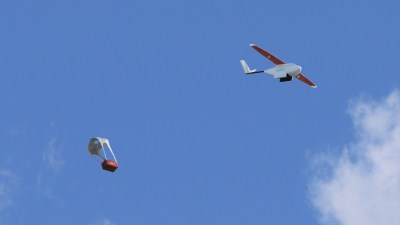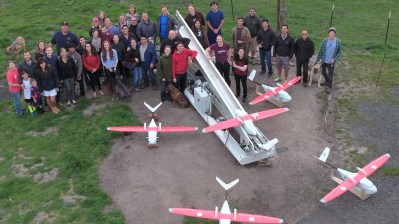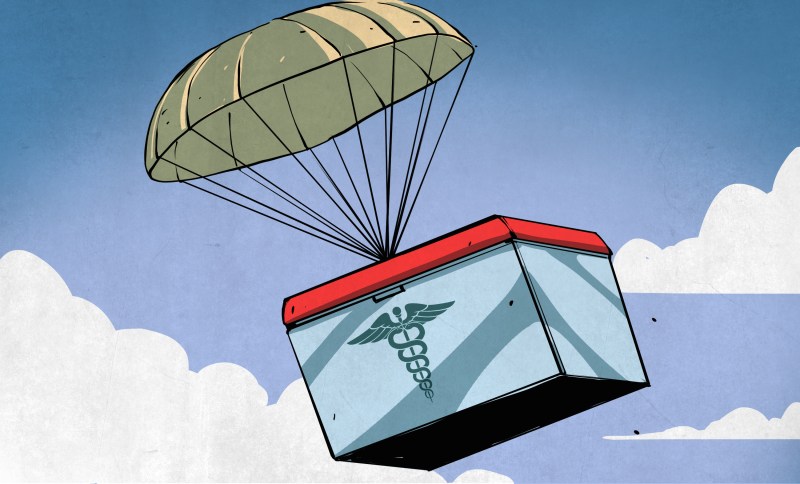Being a cop’s kid leaves you with a lot of vivid memories. My dad was a Connecticut State Trooper for over twenty years, and because of the small size of the state, he was essentially on duty at all times. His cruiser was very much the family vehicle, and like all police vehicles, it was loaded with the tools of the trade. Chief among them was the VHF two-way radio, which I’d listen to during long car rides, hearing troopers dispatched to this accident or calling in that traffic stop.
One very common call was the blood relay — Greenwich Hospital might have had an urgent need for Type B+ blood, but the nearest supply was perhaps at Yale-New Haven Hospital. The State Police would be called, a trooper would pick up the blood in a cooler, drive like hell down I-95, and hand deliver the blood to waiting OR personnel. On a good day, a sufficiently motivated and skilled trooper could cover that 45-mile stretch in about half an hour. On a bad day, the trooper might end up in an accident and in need of blood himself.
That was something like 40 years ago now, and the blood distribution network has surely benefited greatly from the computer revolution, no doubt resulting in much-improved prediction of where and when blood will be needed. As a result, blood relays are probably not as common as they once were.
But in developing nations, and in less densely populated areas of countries like the USA, medical resources are spread thin. And when an hour can make the difference between life and death, there’s bound to be innovation. That’s why Zipline, a drone delivery startup, has targeted rapid medical deliveries by drone as an area for commercialization. And in doing so, they just may have found a great use case for autonomous aerial deliveries.
Forget the glitzy Amazon and Google drone delivery demos. This isn’t buying a Kindle Fire and bag of popcorn and having a quadcopter land in your invitingly capacious and obstacle-free backyard thirty minutes later. Zipline’s innovation is in the use of fixed-wing drones that bear a passing resemblance to such cargo planes as the C-119 Flying Boxcar or the C-82 Packet. The drone has a generous cargo compartment, full GPS and autopilot, and can be launched from austere facilities with the help of a catapult.
 Off-loading the drone’s cargo is — unconventional. Rather than adopt Amazon’s model of designated landing zones for cargo quads, Zipline parachutes the cargo down to the ground from a loitering pattern above the recipient. This obviously has limitations — no Fabergé eggs from eBay. But for certain properly packaged cargos like medical supplies, it’s a workable model.
Off-loading the drone’s cargo is — unconventional. Rather than adopt Amazon’s model of designated landing zones for cargo quads, Zipline parachutes the cargo down to the ground from a loitering pattern above the recipient. This obviously has limitations — no Fabergé eggs from eBay. But for certain properly packaged cargos like medical supplies, it’s a workable model.
The scheme is probably not suitable for urban or even suburban areas, since a fairly large target area free from obstructions is needed. In that way, Zipline suffers from the same geographic restrictions that Amazon’s drones do. But not having to land the drone at the recipient site is a big advantage — no dust, no noise, less chance of accidents, and faster turnaround.

It all may sound fanciful, but Zipline is actually doing this regularly, right now. They’ve been working in the African nation of Rwanda since October, reducing their system to practice. From a base in Muhanga, a fleet of eight Zipline drones has been making drops to far-flung medical centers that would take hours to reach by truck, if at all. By this summer they intend to support a network of twenty hospitals with 15 drones, making regular drops of medicines, blood, and supplies that can make a difference in the health of millions of Rwandans.
To me, Zipline’s model makes far more sense than Amazon or any of the other proposed aerial delivery services. Putting aside for a moment the triviality of delivering a bunch of sunscreen to conference attendees compared to getting a liter of blood to a dying patient, the need to land a powerful quadcopter safely in a suburban or even rural neighborhood seems like a huge obstacle to overcome. Watch any of the rotor-wing drone delivery videos and you’ll notice that the “time over target” is huge, at least relative to the total travel time. The Zipline deliveries are quick — fly, bomb, and scoot. As the drones develop, we might even see multiple payloads in a single drone, each dropped to different sites. As the Zipline CTO points out, “Landing doesn’t scale.” Air drops do scale, and might let Zipline achieve hundreds of deliveries a day.
Add in the fact that fixed-wing aircraft can be faster, carry larger payloads for a given fuel load, and are far simpler to build and maintain than rotor-wing drones, and I think Zipline might be onto something here. It’ll be interesting to see how their experience in Rwanda this summer alters their model, but in the end this could be a real boon to rural medicine in developing nations. And how ironic would it be if delivering lifesaving supplies ended up being the killer app for aerial drone deliveries?
















This looks amazing… Excellent use of technology, kudos to those who started this.
Something tells me the airways are going to be getting pretty busy these next few years.
3d airspace is a big, big place. In the US conventional airplanes (with people inside) are required to maintain about 300 meters (~1,000 ft) separation and half that for flight above populated areas and structures. There is a lot of room for small flying loads underneath that, especially in sparsely populated areas.
Wait until the drug smugglers get a hold of the Ardupilot – a complete cruise missile guidance system for $180. Given that the illegal drug makers now make fentanyl, you have the perfect high value per unit mass drug that can be smuggled by drone plane. No more recruiting “mules”. Fentanyl is 50 times more effective than heroin, which means that half an ounce (20 grams) is as effective as a whole key (Kg) of heroin.
The mission profile would be like this: You go under the border with the drone plane, buy the fentanyl, put it in the plane and launch it. You then go back across the border with no drugs onboard your car, slip past, then drive to the drop zone you programmed into the guidance system. You retrieve the drugs and drone, sell it, and repeat the process.
Now, about painting the drug drone with stealth plane paint….
Poor/non-existent roads are a huge impediment to getting things done in many parts of the world. In many places walking is the preferred mode of transportation because it is so much faster. The technology of small package delivery by air, just like cell phone technology, will make a huge difference because so little infrastructure build-out is necessary for so much awesome. Regulatory stresses however, could be non-trival.
I had a similar experience but my father and later I was a career fire/EMS officer. The ‘company car’ was a way to beep or radio the officer and 24/7 make them available. In my case it was the community taking advantage by making me drive the command car rather than get a real day off ever when in district. For example as an officer and one of only three paramedics in a district covering several thousand square miles I only ever felt comfortable having a beer once I was over 100 miles away, I was never able to do so in my own home. This is not the old 1960s G.I./Baby Boomer generations company car which was a benefit in addition to salary, healthcare, and funded retirement pension For fire and police it means making sure that the public servant is properly equipped 24/7 to provide emergency services or be called to emergency response. Put another way, especially in rural areas with limited staffing, on off days/hours paid cops, EMTs, and firefighters are often converted into unpaid volunteer/reserve responders continuing their paid work.
This was the 60s and 70s and it was a different time. It was a requirement of his job that he not only bring his cruiser home but that he use it for personal transportation. I can’t count the number of times we sat in the car while he saved the life of someone at an accident scene we happened across, using the equipment he carried that certainly wasn’t in our Ford Falcon Futura station wagon. Similarly innumerable are the times he left in the middle of the night from a sound sleep to investigate a murder, or the times he didn’t come home for dinner and we didn’t know where he was (pre-cell phone days) and wondered if he was dead. Getting to use the car was a big perk, yes, but it was small compensation for the times the job took him away from us.
Its not so different in the more rural areas of any country. The population is spread and funding for emergency responders is usually based on how many people live in a given area. This still happens where emergency responders are on call 24/7 pretty much.
There is also a huge difference between the people who ACTUALLY save lives and a guy who thinks he can make America great again through twitter.
The op is a douche who is so butt-hurt by his own internal conflict that he must lash out and make any subject about his own insecurities. Personally i think you wrote a great article and the lead in of your personal experience was a good humanizing touch.
Thanks for pointing out that ordering the patrolman to do their errands in the cruiser is a wee bit different than the corporate raider winging off to Fiji on a tax-deducted jet. In one case it becomes defacto 24/7 job, in the other tax payers are subsidizing a vacation.
Yeah, like rich and poor wouldn’t be paying it through increased prices if i wasn’t deducted. If deducted (they don’t deduct from the taxes, only from income on which taxes are paid) it is only “paid” for by those who pay taxes.
I could see combining this with a dirigible or fleet thereof that flies a route. The dirigible(s) could provide warehousing and bulk cargo, the drones could do final delivery, and the dirigible(s) could be resupplied by aerostat. The dirigibles need never land. That could extend delivery range quite significantly.
Imagine a disaster in a poorly accessible place. Dirigibles loaded with supplies leave their standard routes, and head for the disaster zone. As soon as they’re in range drones drop from their bellies and race to the scene with immediately needed supplies. Once on site, the dirigibles could drop and aerostat package to lift the expended (fuel/battery) drones back up and they could be put back into service.
In a lot of areas it’s encouraged to take the cruiser home with them and use it a lot. When you’re in a more sparsely populated area it’s beneficial to have people see the cruiser on the road instead of sitting in a parking space. They never know if that officer is on duty or not, and adjust their behavior accordingly.
” no doubt resulting in much-improved prediction “.
Not so much. We have motorcycles and vans running the stuff around the UK.
Paid staff during the day and a lot of dedicated volunteers outside of working hours doing emergency blood runs that cant wait till the next working day.
Your lack of logic is actually astounding.
There is a difference between trumps family using his status and the public property that he has been given for personal gain and a community that needs emergency responders and as such requires them to be on the job at all times.
Thanks for being an insensitive clod, why don’t you go live out in an extremely rural area of your state and see how life is completely different than in denser populated areas.
I appreciate the thoughtful and constructive responses from Dan Maloney, dave and Dougmsbbs.
The only way TRUMP could do any good here would be if he out of his money not yours, finance a hole fleet of over 200 – 300 planes. And not have it published or say anything but just do it.
Then I would have something good to say about him.
Or any of the top 100 of the rich and famous.
And the amount of money it would cost them would be like one of us going and buying a coffee.
I would love to do this. But Im not rich.
Good luck
I really hope that this works out the way it should.
If it doesn’t work then it has failed because of politics, not because of a poor idea. This is a great Idea.
And I hope that other areas and countries start up new sites as well.
I cant help financially but if there are people out there that can help. That have a lot of money. ( Rich ) Please Help.
Good Luck.
He managed to breed?
I see others have pointed out you glossed over “24/7”. Also pointed out perk give LEO and other public servant a chance to have resemblance of family life. Like any POTUS Trump is on call 24/7, but is unlikely to respond to an event personally to render aid.
Wouldnt a highline between 2 flag poles and an upside down (think bumper cars or delorean and clock tower from Back to the Future) aircraft carrier style cable arrester system work for recovery?
You would just have to have the highline higher than the arrester is long (say 30+ feet in the air which adds to safety if you have to make another pass). Then have a tail hook above (like 8ft to avoid hitting wire with drone) with a caribeaner type closure so it cant come off the wire. The plane would come in under the wire and once it detects capture it would kill throttle and then swing until it came to rest, then lowered (hence flagpoles) to the ground. Then use a catapault to relaunch (which could be hooked vertically to one of the flagpoles).
A blimp, albeit slower, might make for safer, larger deliveries.
Bad weather is a problem for all this though.
Might make for an interesting delivery method after a flood or snow storm of roads are obstructed.
This will be great for the autonomous organ harvesters! They can get right to the motorcycle fatality and fly off to the hospital so quickly that they won’t even need ice!
Parachutes for humans are steerable…i’d love to experiment with a way to add a little control to the payloads for greater drop accuracy. i understand there would be a cost trade off but they eventual return of the payload system via less urgent means would help.
No reason you can’t! Even a light weight quad can auto orient quickly.
Seems like the quadcopter and fixed wing drones could be used together, where the fixed wing delivers the package and the quadcopter lands it. It would increase the price, but the quadcopter used would only need to get the payload to the ground and would be able to be much more precise than a parachute
Would you prefer a cheap drone/quadcopter or a more expensive (and possibly more reliable)?